iPhone 17 Pro Review: Walking Lines in Parallel
Design doesn’t have to be beautiful
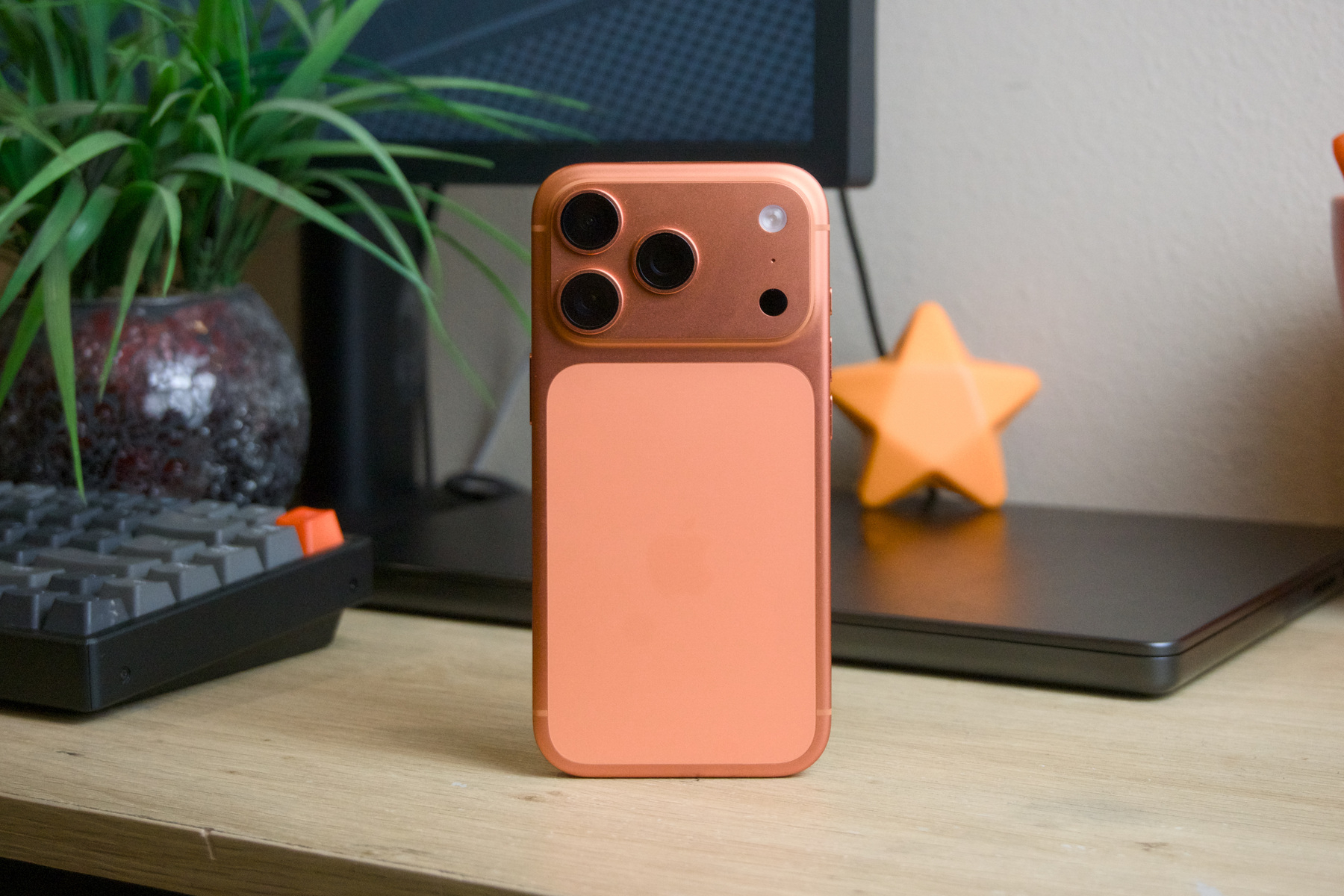 iPhone 17 Pro in Cosmic Orange.
iPhone 17 Pro in Cosmic Orange.
When I received my Cosmic Orange iPhone 17 Pro and took it out of its box on launch day, I wasn’t really sure where I’d begin my review. Every year since iPhone Xs, the new iPhone has always had a marquee feature worth discussing. iPhone 11 Pro had the ultra-wide camera, iPhone 12 Pro brought 5G and MagSafe, iPhone 13 Pro brought ProMotion and the macro camera, iPhone 14 Pro introduced the Dynamic Island, iPhone 15 Pro used titanium for the first time and replaced the mute switch with the Action Button, and iPhone 16 Pro enhanced Photographic Styles and introduced yet another new button, Camera Control. However, after using iPhone 17 Pro for over a week, this device has received more public attention than I’ve ever experienced. People can’t help but look at the stunning Cosmic Orange finish and the redesigned camera plateau — two design changes that add a fresh new look to the iPhone for the first time in six years.
Ultimately, that’s the story of iPhone 17 Pro: It’s a redesigned iPhone, made from the same material Apple has used on low-end iPhones every year, save for iPhone 3G and iPhone 3Gs. It runs cooler and takes better photos thanks to the higher-resolution telephoto lens. It’s a bit heavier, thicker, and has better battery life. It runs iOS 26 like butter, and have I mentioned Cosmic Orange is a stunner? The story of this device is not of technological innovation — rather, it segments Apple’s foremost purpose as a lifestyle company. People like the new iPhone not when it brings something new to the table, but when it looks different. I’m not sure I’ve heard a single person say they enjoy using Camera Control on their iPhone 16, but the Dynamic Island gets its 15 minutes of fame on social media every month when another person upgrades their iPhone and sees sports scores at the top of their screen. New looks sell.
I have strong opinions on the new design this year, and I’ll be sure to discuss them at length. I’ve taken some great photos with the telephoto lens and find the new 8× focal length to be quite creatively inspiring, and I’m eager to share the images I’ve captured using the device. This is yet another iPhone review written by someone who appreciates Apple products, and readers should expect the same treatment I give the iPhone every year. But I also think it’s worth evaluating iPhone 17 Pro not purely from a technical standpoint, but by admiring the cultural icon it has become. This iPhone is not “worth it” any more than any previous iPhone. We’re past the point where a new smartphone is “worth it.” But it’s important — more important than any iPhone since iPhone 11 Pro, because it takes some bold steps forward and a few steps back.
Each iPhone this year has taken those steps. They’re all walking lines in parallel that will never meet, and it’s just as well.1 If the slope of the line iPhone 17 Pro walks changed even the slightest, it would collide with the others and wreak havoc on Apple’s iPhone lineup, the company’s cash cow for over a decade. But it didn’t — it just moved forward in some ways and backward in others. Analyzing why and where it took those steps comprises the soul behind these reviews, and why I seem to never run out of things to say about incremental iPhone updates. The iPhone this year, like every other year, begs the same questions, and the figurative lines are more interesting than ever before.
Design
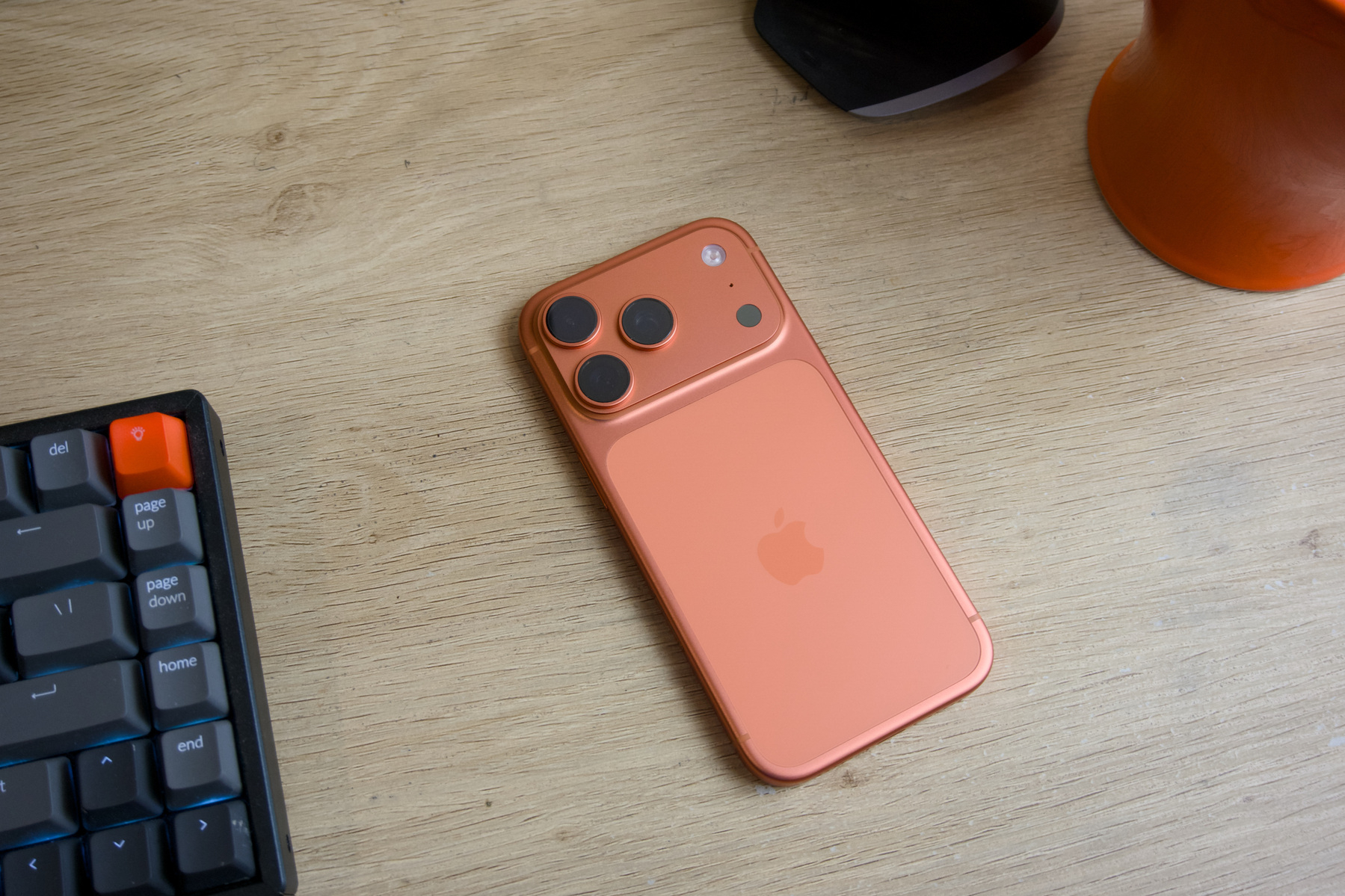 Cosmic Orange is stunning.
Cosmic Orange is stunning.
I haven’t led a product review with a section explicitly titled “Design” in a while — the closest I’ve gotten was discussing the titanium side rails on iPhone 15 Pro two years ago. iPhone 17 Pro’s design takes two steps back and one monumental leap forward, leading to a functional yet distinctly un-Apple look and feel of the device that, for the first time since iPhone 11 Pro, has led me to outwardly dislike the iPhone’s appearance. The device’s frame is made using aluminum, winding back to the roots of the iPhone and more or less matching the material design of the low-end model for the first time since iPhone X in 2017. The side rails are even circular and curved, mirroring the pre-iPhone 12 design era, but they still retain some aspect of rectangularity. The whole device uses a “unibody” design to house the camera plateau — Apple’s new term for the camera area at the back — in aluminum.
Aluminum is a light, easy-to-work-with material, and there’s a reason it comprises the exterior casing in nearly every one of Apple’s product lines. Aside from being inexpensive, it’s trivial to manufacture and color using anodization, leading to the bright, beautiful finishes of products like the base-model iPad and iMac. But it has its downsides: It feels tawdry compared to more sophisticated metals like titanium or stainless steel, and it dents and scratches easily. The latter drawback is prevalent because aluminum is a soft, malleable metal — when it’s dropped, it instantly scuffs and dents. The anodization also wears off after contact with soft metals, like keys, around the edges due to how it is applied around sharp corners. It even wears off after extended contact with skin oils. There’s no better example of aluminum anodization’s lack of durability than years-old Mac laptops: After only a few years of use, the palm rests of my Space Black MacBook Pro are visibly lighter than the rest of the chassis, and some parts of the sharp corners have micro-abrasions revealing the uncolored aluminum underneath.2
Aluminum is a great material for many products, like Mac laptops and other products where weight and the amount of material used are important considerations. A MacBook Pro made from titanium would be obscenely expensive, and a polished stainless steel one would weigh more than anyone would want to carry in a bag. But on the iPhone and Apple Watch, titanium and stainless steel are great materials that add a beautiful finish to the rim of the device. I’m even willing to throw stainless steel under the bus — titanium was the perfect material for the Pro-model iPhone, as I remarked in my iPhone 15 Pro review. It felt premium and solid, and it never scuffed. My iPhone 16 Pro — which I used caseless for the year I had it and have dropped numerous times, including on concrete — doesn’t have a single scratch or scuff on the frame. It’s in near-mint condition. By contrast, every (portable) aluminum Apple product I’ve owned, including Apple TV remotes, has a dent or unsightly gash in its frame less than a year after purchase. That’s not carelessness — it’s just a symptom of using a malleable material like aluminum.
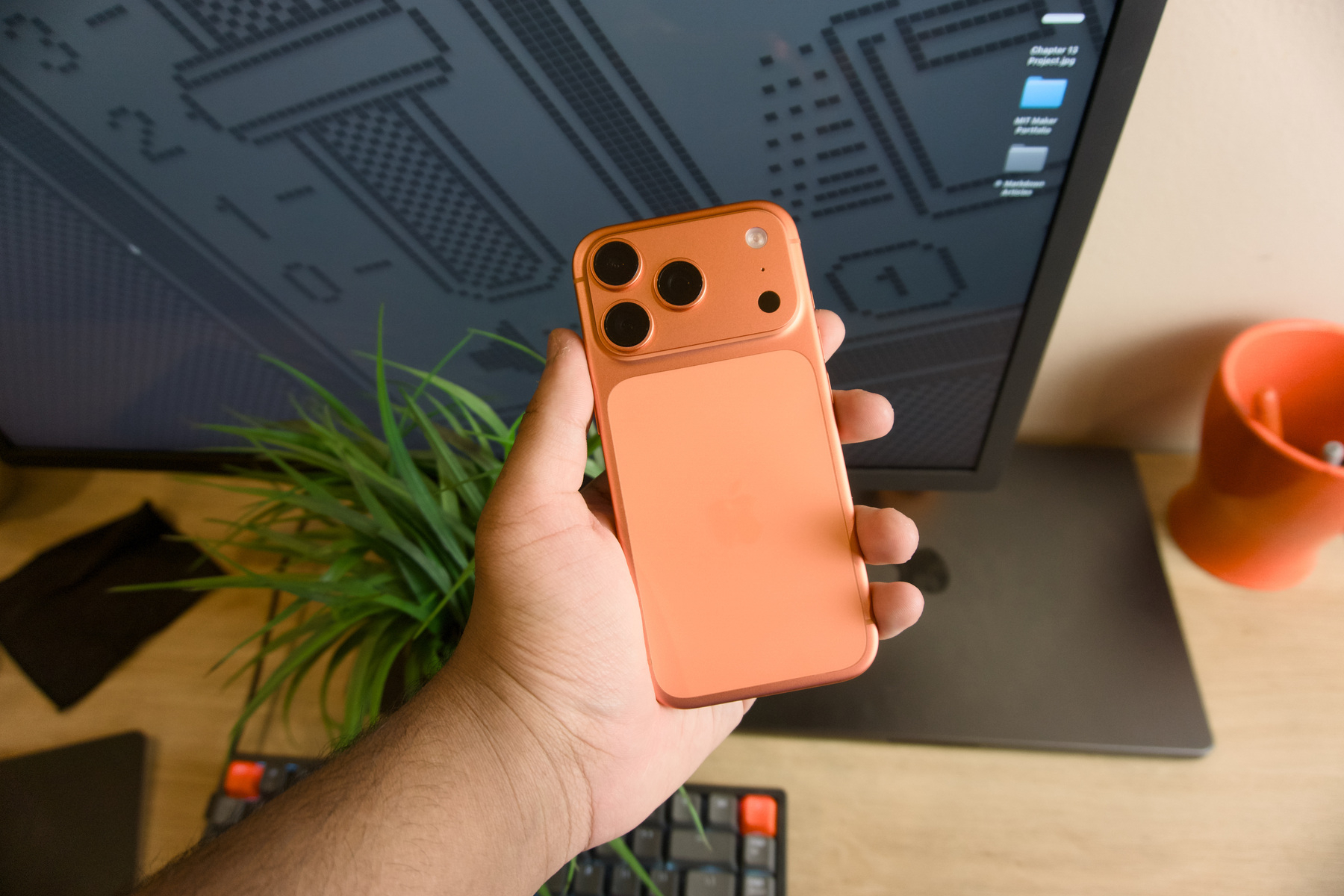 Aluminum does look nice from some angles.
Aluminum does look nice from some angles.
iPhone 17 Pro exaggerates these concerns. As soon as I took it out of the box, two things struck me: its weight and hand feel. It felt heavier than my iPhone 16 Pro — which is backed by quantitative measurement; iPhone 16 Pro weighs 199 grams versus 206 grams — and, more importantly, was slipperier. This was my first aluminum iPhone since iPhone 12 five years ago, but it was worse than I remembered because most of the casing is made from aluminum. Whereas older aluminum iPhones used a glossy glass back, iPhone 17 Pro’s aluminum extends to the back and is only interrupted by a small patch of matte glass. My freshly washed hands were instantly scared of dropping the phone. It also feels oddly cheap, like a product unworthy of the $1,100 price tag, though I’m sure part of this is just being unaccustomed to an aluminum iPhone again. I still prefer the hand feel of my iPhone 16 Pro and find it to be more grippy and aesthetically pleasing.
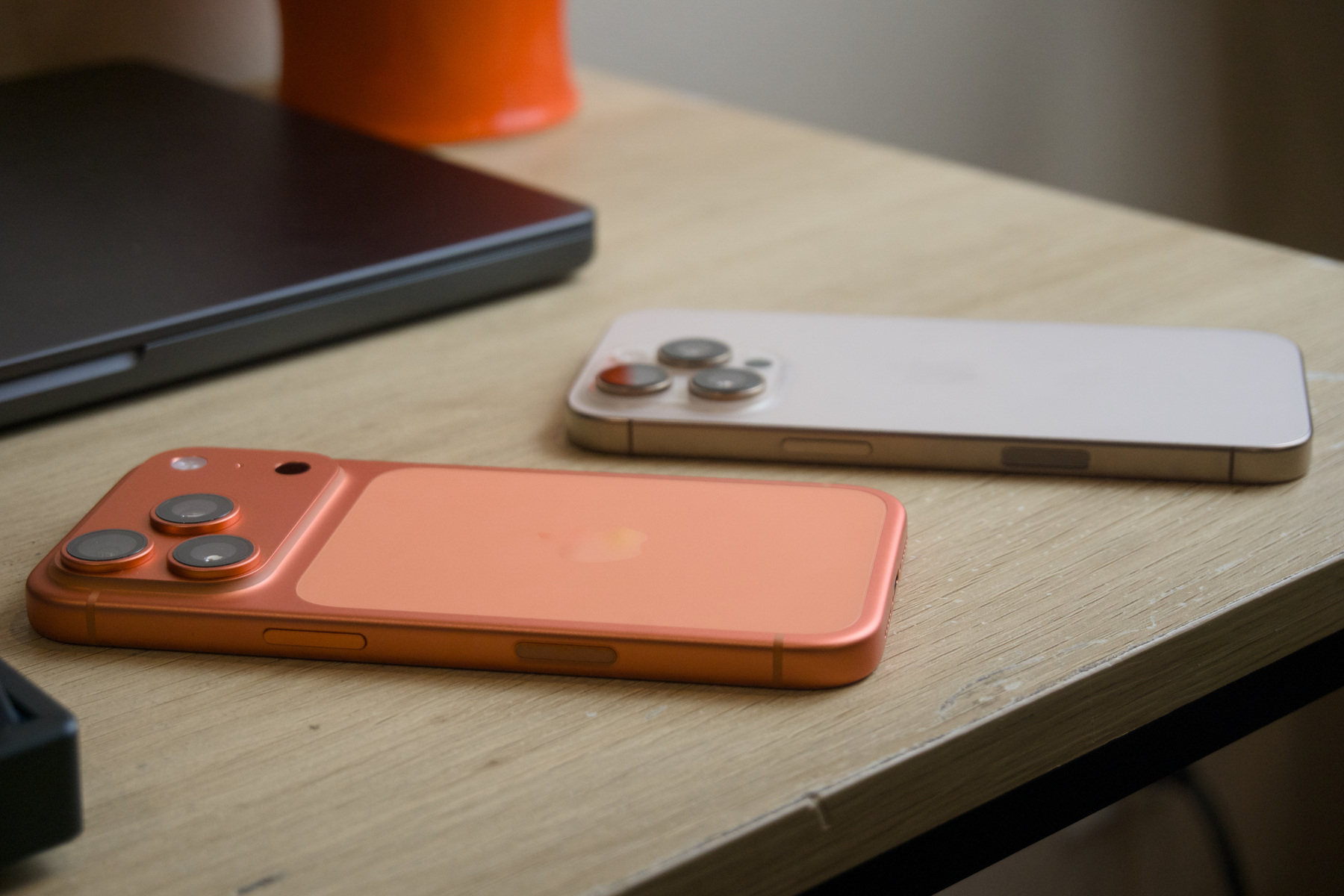 iPhone 17 Pro is slightly thicker and larger than its predecessors.
iPhone 17 Pro is slightly thicker and larger than its predecessors.
The enhanced side rail curvature, however, is a nice transformation from prior models. I am a proponent of the sharp, post-iPhone 12 boxy design, but my hands prefer the older curved edges. I only realized how much I missed them after I used my iPhone 15 Pro, which reintroduced curvature, and iPhone 17 Pro only builds on that design. The edges are still straighter than older iPhones, but they feel much nicer, and I especially like how light reflects off the edges — it reminds me of the chamfer on iPhone 5s. The screen’s corner radii, however, are not more rounded, which is a departure from prior iPhones. Every year, Apple has made minor revisions to the roundness of the screen’s corners, but this year, the display’s bezels, size, and design remain identical to last year’s model. The phone is not discernibly larger, but it is thicker, presumably to accommodate the larger battery.
The display is made from Apple and Corning’s new Ceramic Shield 2 cover glass material, which aims to increase scratch resistance. While I can’t comment on its efficacy yet, I can confirm that the new antireflective coating doesn’t make a tangible difference in light reflections. In fact, it appears almost equally ineffective at alleviating these reflections when the screen is dim or off compared to my iPhone 16 Pro. The only discernible difference is that the new model is better at resisting fingerprints, but that is likely just a byproduct of a fresh oleophobic coating. It’s certainly nowhere near as good as the nano-texture coating found on newer MacBooks Pro and Apple displays, but I also don’t think it has to be; I’m still able to read the display perfectly fine in direct sunlight due to the increased peak brightness of 3,000 nits.
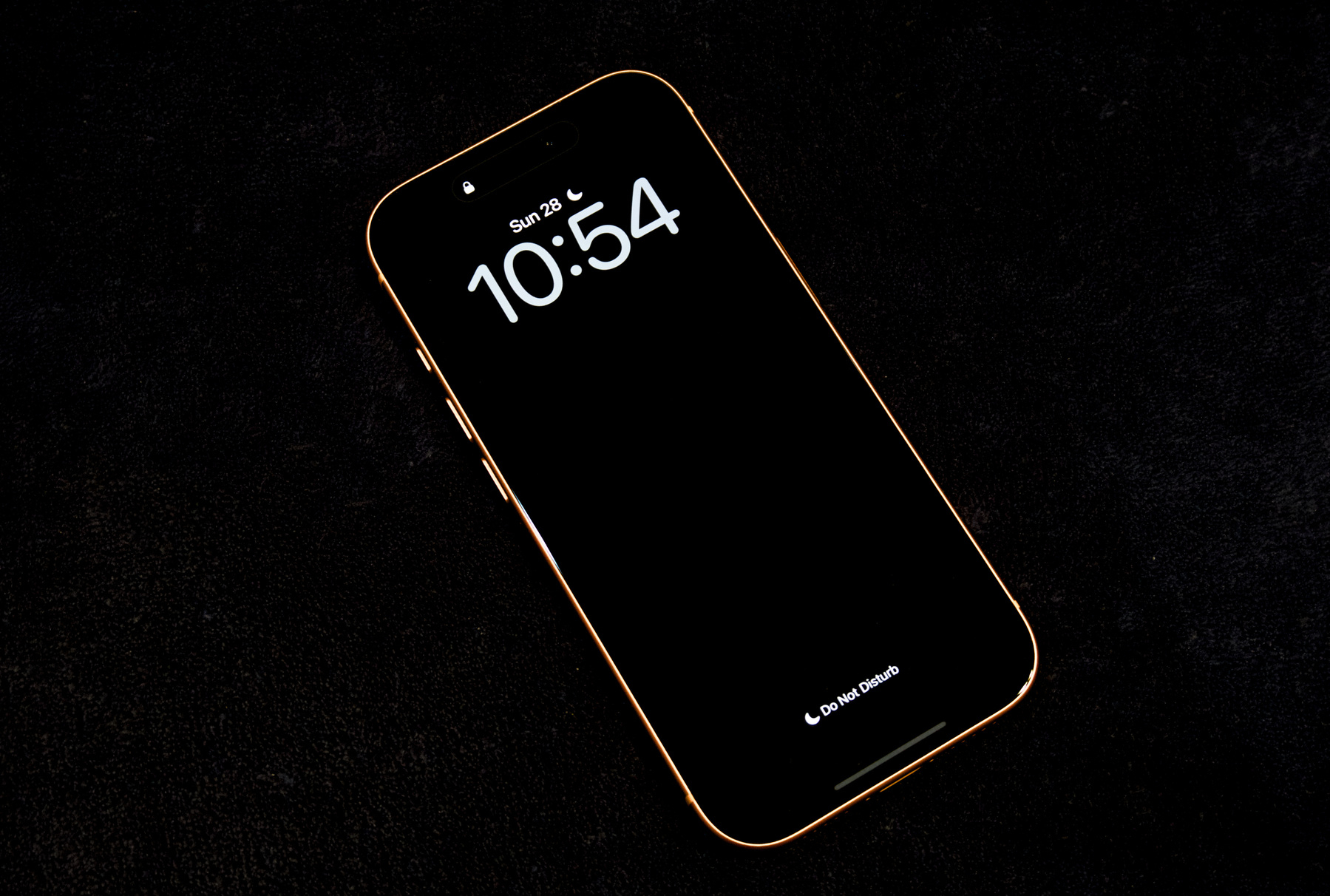 Cosmic Orange from the front.
Cosmic Orange from the front.
The primary difference in outdoor legibility — or usability at all — between older, stainless steel- and titanium-based iPhone models is not the screen’s brightness, though, but the vapor chamber cooling apparatus in iPhone 17 Pro. Coupled with the aluminum chassis, which is a better conductor of heat than titanium, iPhone 17 Pro runs noticeably and remarkably cooler than any of its recent predecessors, even when connected to 5G and using the camera at peak brightness on a warm early-fall day. The titanium iPhone models would overheat so severely on 5G outdoors, despite having extremely efficient processors, that they would thermal throttle performance and artificially dim the screen when under peak workload. iPhone 17 Pro doesn’t behave this way and doesn’t feel akin to molten lava when outdoors. It’s easily the largest quality-of-life improvement this year, and I’m glad this glaring omission has been rectified. (The only time I’ve felt it get moderately warm is when it was charging via MagSafe on a pillow, hardly an ideal circumstance.)
One last note on aluminum’s affordances: the Cosmic Orange finish this year is genuinely gorgeous and easily one of my favorite iPhone colors. It especially looks spectacular in the light, and the dual-tone contrast between the lighter Ceramic Shield and rich orange aluminum frame makes for a device that reminds me of the tangerine iBook Elle Woods used in the iconic “Legally Blonde” scene. It is an eye-catcher that highlights the beauty of aluminum as a material, and I’ve gotten more looks from passersby than I have using any other iPhone I’ve had. (This is especially bad as an introvert because most people ask if this “is the new iPhone” with enthusiastic amusement, and I must gently condense thousands of words into a 20-second review of the device without sounding like a dork, but I digress.) The excitement for this phone is genuinely off the charts, and I attribute most of it not to the new unibody design, but the Cosmic Orange color.
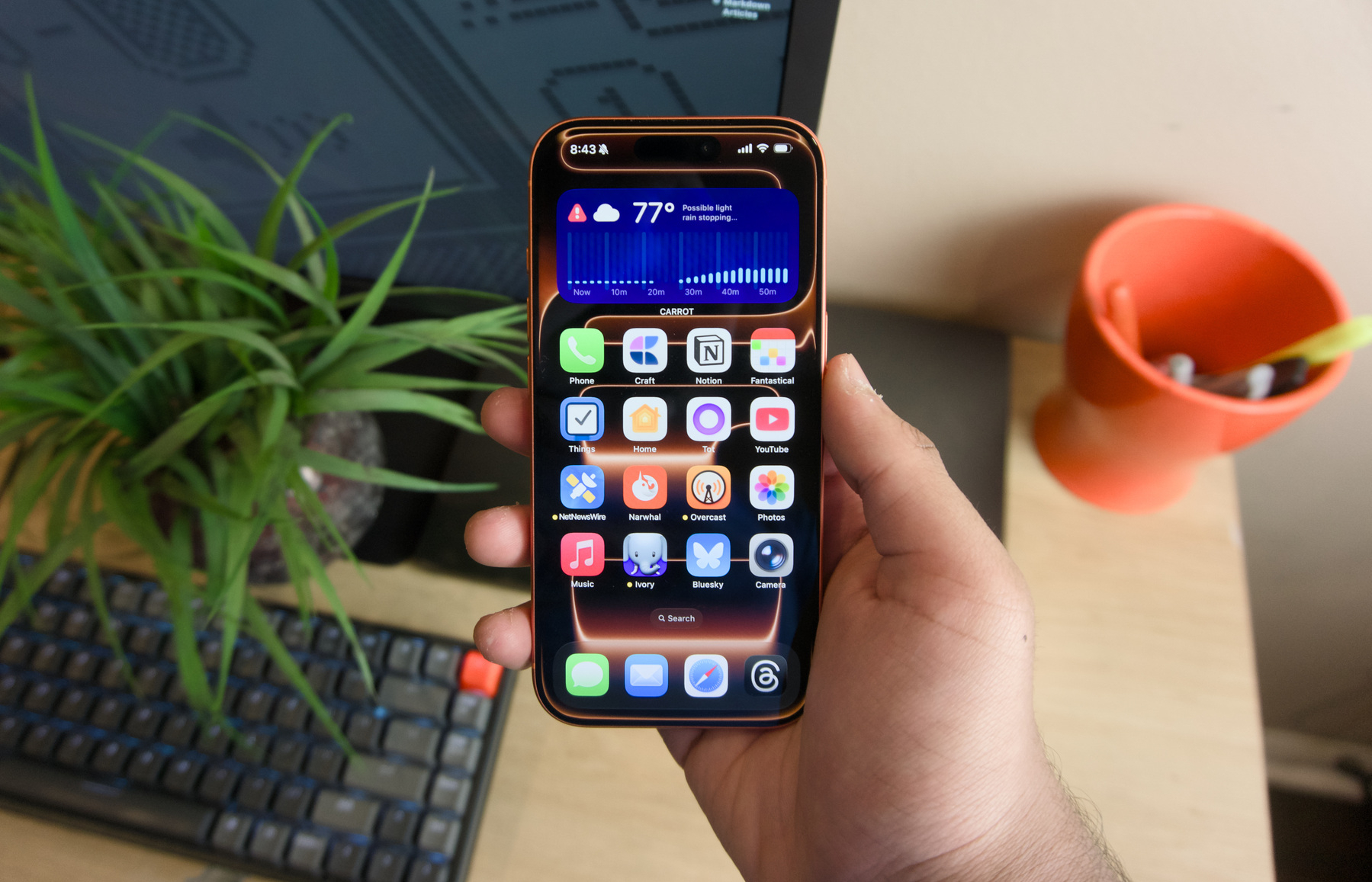 iPhone 17 Pro doesn’t look all that different from the front.
iPhone 17 Pro doesn’t look all that different from the front.
All of this is to say that aluminum has its own strengths, and those strengths are why I initially positioned this redesign as two steps backward and one leap forward. In many ways, this new redefinition of the iPhone’s timeless design is everything I’ve wanted from Cupertino for years: a bold color choice, a cooler chassis, and something to bring excitement back to the iPhone. For the masses, a redesign is innovation, and Apple’s designers are as much creative engineers as they are people who boldly reframe fashion for the years to come. iPhones are cultural fashion icons as much as Ray-Ban sunglasses or Guess handbags are, and an iPhone redesign every few years keeps culture marching forward. At the same time, I find the design overall to be too robotic — especially surrounding the unibody camera plateau and optically off-center Apple logo — and in need of minor revisions.
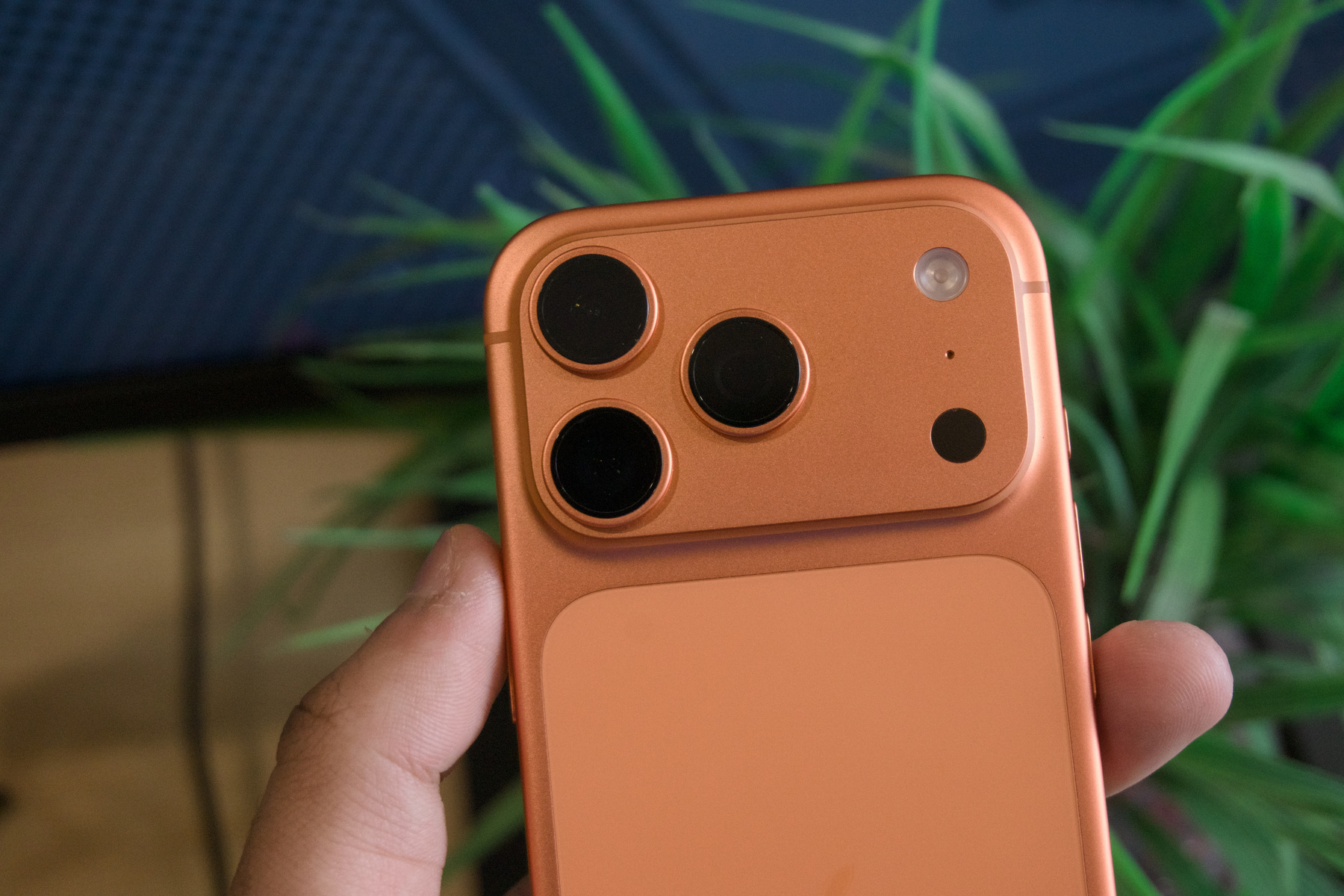 The camera plateau.
The camera plateau.
Camera
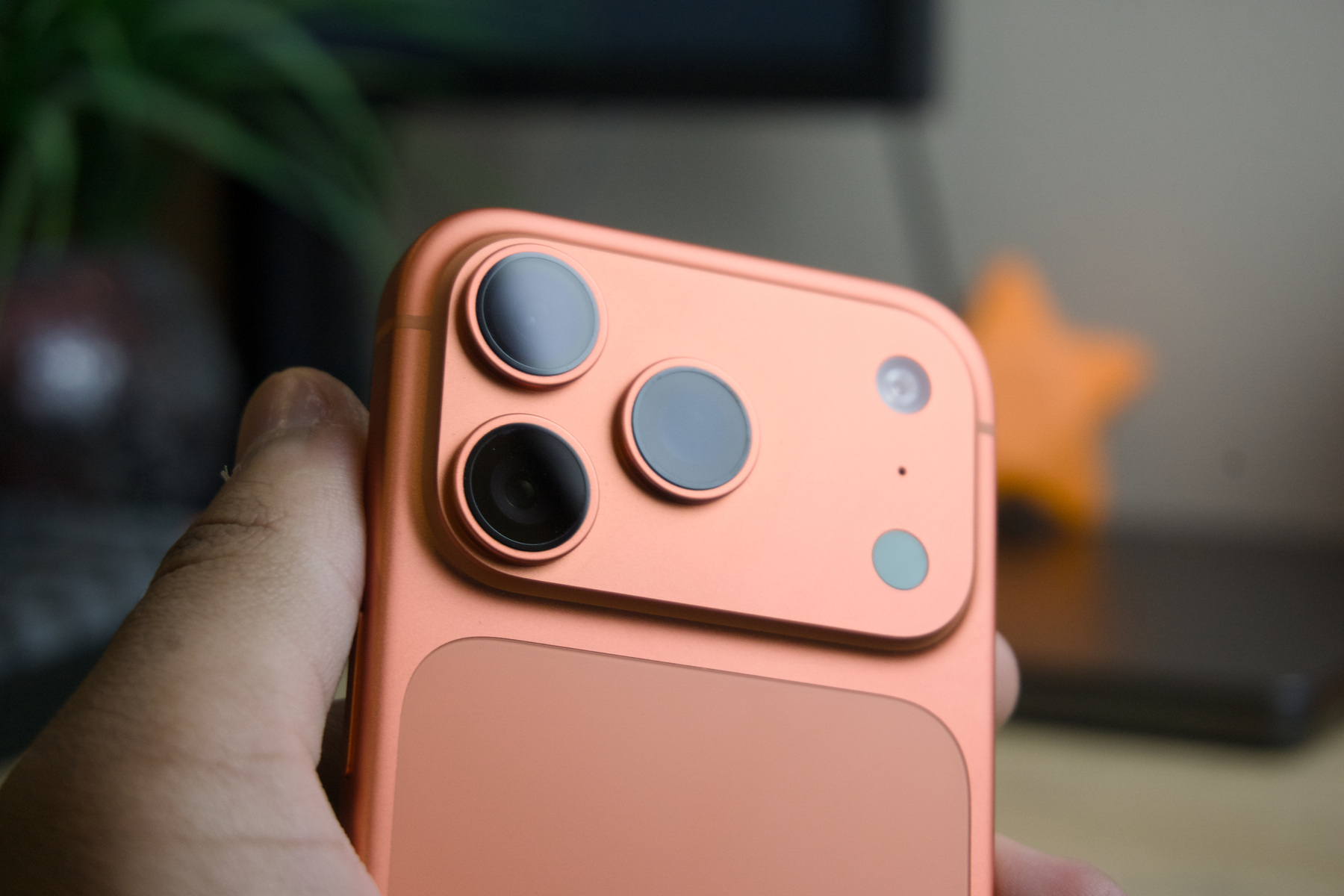 iPhone 17 Pro’s camera improvements are modest.
iPhone 17 Pro’s camera improvements are modest.
The best way to think about smartphone cameras in the 2020s is that they’re the effective replacement for point-and-shoots and DSLRs, the kinds of cameras people carried around 10 years ago to birthdays, vacations, and parties. There’s no special moment impossible to capture with an iPhone camera because they’re so good nowadays. By “good,” I don’t mean the sensors are markedly improved or better than even a cheap mirrorless camera, because an APS-C sensor would crush any of the “lenses” on even the highest-end smartphones. Rather, the processing pipelines and feature sets have become so advanced that occasions when someone finds themselves in a situation needing a better camera than the one in their pocket are few and far between. Smartphones are the new cameras, just as MP3 players are a vestige of the past.
iPhone 17 Pro’s camera is not markedly better than last year’s model, or even the one from three years ago. I know this because photos from the newly released iPhone Air — which uses the same sensor as the two-year-old iPhone 15 Pro — and iPhone 17 Pro look nearly identical even when capturing complex subjects. But I can say that iPhone 17 Pro is more versatile at capturing a variety of subjects and scenes, allowing for more creative flexibility and bringing the smartphone closer to a bulky camera bag full of lenses. The point is for the iPhone to one day be as adept as a bag full of glass in a variety of situations, including video, long-range photography, and macro photos, while still being easy to use. iPhone 17 Pro inches closer to that ideal and takes baby steps forward on its figurative “line.”
 iPhone 17 Pro, 4×.
iPhone 17 Pro, 4×.
Each of the sensors (i.e., “lenses,” which is an irrelevant misnomer) — main, ultra-wide, and telephoto — is now 48 megapixels in resolution this year, which means they’re higher fidelity but not any larger in physical area. Megapixels are, in my eyes, an obsolete measurement of image fidelity because they do not measure sensor size, only total possible resolution, which machine learning-powered upscaling has handled on smartphones for over a decade. How large the sensor is directly correlates to better exposed, higher-detail, less noisy shots because larger sensors let more light through — there is literally more detail to capture when the sensor is larger. This remains my biggest qualm with smartphone photos and why I carry around a mirrorless camera with a much larger sensor (but fewer megapixels) when I truly care about image fidelity: smartphone photos, despite post-processing, are still grainy and noisy at times when they shouldn’t be, especially when using the telephoto lens.
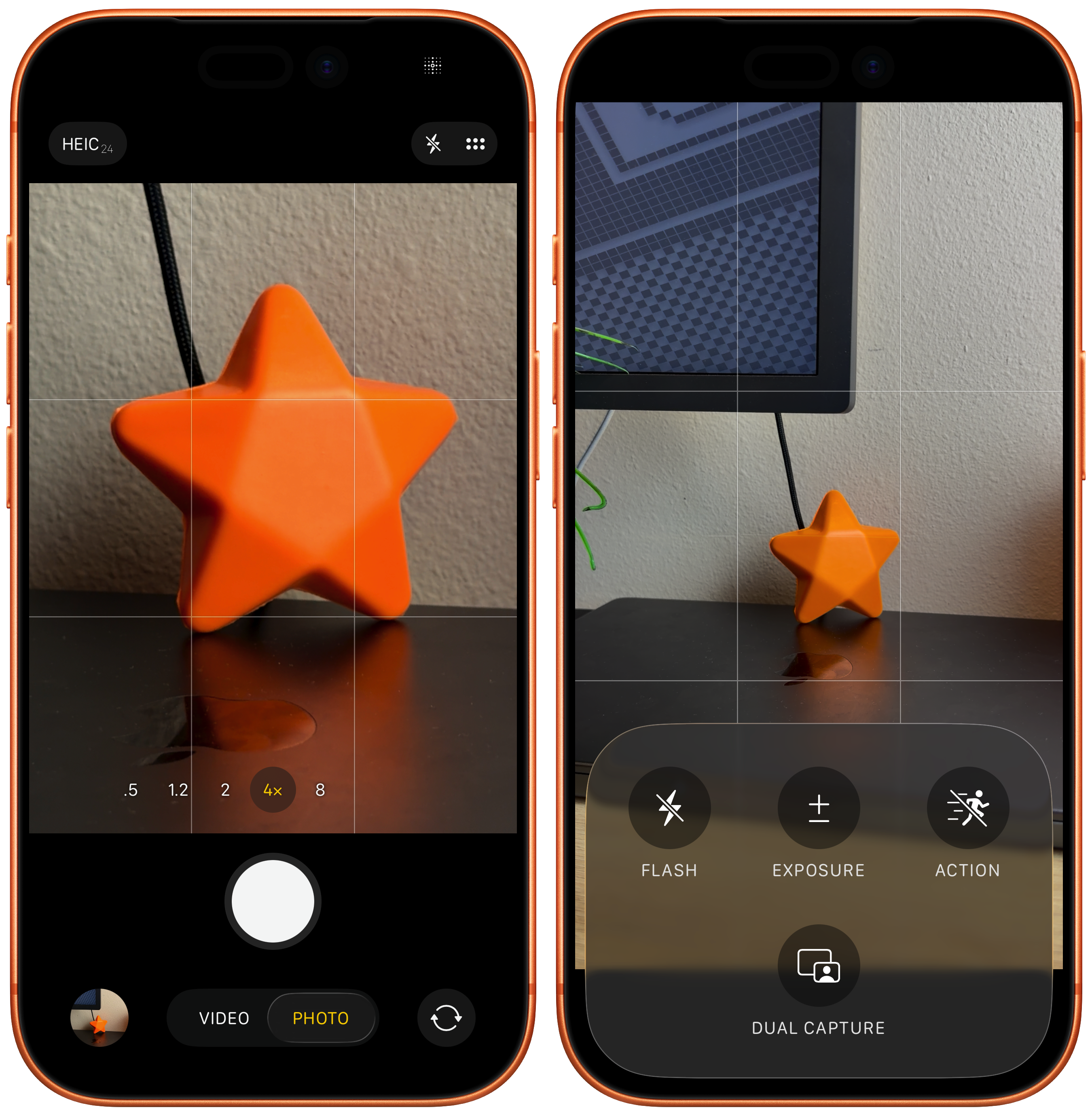 iPhone 17 Pro has five zoom lengths.
iPhone 17 Pro has five zoom lengths.
My favorite iPhone lens to shoot with is the 2× crop of the main sensor, which still remains the largest sensor on the iPhone. While the crop means photos are at 12 megapixels, they’re still shot with the best sensor on the device that captures the most light, leading to beautiful shots with great bokeh and stunning detail. The 2× binned cropping mode, first introduced to iPhone 14 Pro, also has an analog-equivalent focal length of 48 millimeters, which is close to 50 millimeters — about the same as the human eye for natural-looking photos. But the real telephoto lens has always engendered the most creative, quirky shots, and thus, is why I’m happy to see it has been ameliorated.
 iPhone 17 Pro, 2×.
iPhone 17 Pro, 2×.
The telephoto lens now shoots at 4×, or 100 millimeters, which is shorter than the 5× lens of older iPhone models but enables more versatility. I solidly prefer it over the 5×, especially because it hits a nice golden mean between the 3× — which I disliked for being awkward — and the 5×, which I enjoyed using a lot more, as I remarked in my iPhone 16 Pro review last year. If they end up reverting back to the 5× next year, I’ll be disappointed; I think 100 millimeters is perfect for most creative shots, while the 2× is much more helpful for day-to-day photography. For photos that really need a tighter focal length, the new 8× crop (200-millimeter equivalent) functions using the same pixel binning technique as the 2×, but uses the higher resolution 4× telephoto to zoom in.
 iPhone 16 Pro, 5×.
iPhone 16 Pro, 5×.
 iPhone 17 Pro, 4×.
iPhone 17 Pro, 4×.
As much as I enjoy the new focal lengths, there’s a reason I wrote that spiel on sensor size earlier: The 4× telephoto is simply not high-quality enough. While the camera system this year is more adaptive overall, picking up more “glass,” the 4× telephoto struggles in low-light conditions just as much as its predecessor. This comes back to megapixels versus sensor size: While the 4× has more megapixels, it does not allow more light to hit the sensor, leading to grainy shots where post-processing must pick up the slack. This was my problem with the telephoto lens ever since it was introduced in iPhone 7 Plus, and I’m disappointed that Apple couldn’t figure out how to make the sensor larger. Images captured in well-lit conditions, such as golden hour, clearly have more detail when zooming in on small details like leaves, bushes, and birds flying sky-high. But when night falls, image quality still suffers immensely vis-à-vis the main camera, which enjoys a larger sensor.
 iPhone 17 Pro, 4×.
iPhone 17 Pro, 4×.
 iPhone 17 Pro, 8×.
iPhone 17 Pro, 8×.
When iOS detects someone is using the telephoto lens in a low-light setting, it defers to using a crop of the higher-quality main camera instead.3 This has always been an implicit admission from Apple that the telephoto lens is significantly smaller and lower-quality than the main camera, and with this year’s improvements, I expected the switching to be less aggressive since the image processing pipeline would have more resolution to work with. This, much to my chagrin, is not the case, and I find iPhone 17 Pro to switch lenses in the dark as frequently as all of its predecessors. This is unfortunate not just because it demonstrates the telephoto is low-quality, but that I find the telephoto would do a better job at capturing 4× shots than the main sensor in almost every scenario. This is wishful thinking, but I wish Apple would give users a way to disable this indiscriminate lens shifting, just like Macro Mode can.
 iPhone 17 Pro, 4×.
iPhone 17 Pro, 4×.
In the meantime, this limits my ability to recommend the telephoto lens in all scenarios. 4× shots still appear grainy in some circumstances, and the 8× is unusable aside from outdoor photography in direct sunlight. Even then, the image processing pipeline heavily distorts photos shot at 8×, more so than the 2× binned focal length, leading to some unsatisfactory images with smoothed edges, blotchy colors, and apparent over-sharpening. It’s a good utility lens, and is certainly fun to play around with in good lighting, but it’s not perfect by any stretch of the imagination. The 4× crop is much more pleasant to use, albeit lacking in some conditions, and is, again, much improved detail-wise in well-lit conditions compared to prior models. There really is a tangible difference, even over iPhone 16 Pro, but again, it doesn’t activate reliably enough for me to mark it as a solid improvement. Overall, I still find myself using the 2× crop more than any other lens.
 iPhone 17 Pro, 8×.
iPhone 17 Pro, 8×.
 iPhone 17 Pro, 8×.
iPhone 17 Pro, 8×.
The same goes for the 0.5× ultra-wide lens, which I find minimal both in utility and fidelity. It has also been upgraded to 48 megapixels, but the only time that I find it activates is unintentionally via Macro Mode. Macro images are certainly higher resolution on iPhone 17 Pro, but they’re also softer and noisier than any photo taken with the main lens. The ultra-wide camera’s sensor is probably the smallest of the three, and thus, permits the least amount of light to hit the sensor, resulting in photos that are almost universally poor in medium- to low-light conditions. I really only think it’s useful in direct sunlight to capture creative pictures of landscapes. But Macro Mode unwittingly remains the only unavoidable use case for the ultra-wide lens due to its minuscule minimum focus distance, and thus, it is where the resolution improvements to the ultra-wide camera are the most appreciated.
The main camera, due to its focal length, has a relatively poor minimum focus distance of 200 millimeters, whereas the ultra-wide lens has a minimum of 20 millimeters. Due to this limitation of the main camera — which goes out of focus when an object is close to the lens — iOS switches to a crop of the 0.5× lens when it detects an object is less than 200 millimeters away from the lens. The result is that close-ups of text and other smaller objects are noisier, blurrier, and exhibit more vignetting around the corners, as the ultra-wide sensor is so much smaller than the main camera’s. I say this is “unintentional” because Macro Mode is often not what people want when they’re capturing most objects, and people (including myself) forget to check if Macro Mode has been automatically enabled when capturing a photo.
The minimum focus distance limitation of the main camera has irked me since iPhone 14 Pro, which featured a noticeably improved main camera, so all of this is to say that I wish iPhone 17 Pro could capture objects nearer to the camera without switching to the inferior ultra-wide lens. In the meantime, Christian Selig, the all-star developer of the iOS apps Apollo and Pixel Pals, wrote about a tip that has proven handy for close-ups: disable Macro Mode and use the 2× lens to zoom into subjects via the main camera. I can’t believe I haven’t thought of this before, and I really think Apple should make it a setting — perhaps it could call it “Use 2× Lens for Macro Mode.”
 iPhone 17 Pro, 1×.
iPhone 17 Pro, 1×.
The front-facing camera is an oft-overlooked aspect of these reviews, but truthfully, I think it’ll be one of the most beloved features of this year’s devices. It has not improved in sheer resolution, but the sensor is both larger and square, allowing the system to let people “rotate” the images without physically moving the device. I surmise this will be a hit among frequent selfie takers, and because it is ultra-wide, I believe the greater field of view will be, too. The front-facing camera, when holding the device in its portrait orientation, defaults to portrait with Center Stage off unless it detects there are many people in the photo. Then, it will intelligently recommend switching to landscape, and might even enable Center Stage if necessary. (There is no setting under Settings → Camera → Preserve Settings to tell iOS to remember Center Stage and orientation adjustments, unfortunately.) It’s not groundbreaking, but a quality-of-life improvement nonetheless.
That’s ultimately where I land on iPhone 17 Pro’s camera upgrades: not groundbreaking, but quality-of-life improvements are present across the board. That’s not even because I’m comparing it to last year’s model — the iPhone camera improves marginally each year, and this one is no different. I like the new 4× lens for its increased detail, but still find it limiting in certain low-light conditions; the 8× suffers from the same problem, and the 0.5× ultra-wide is still lackluster at best. But together, the camera system is still the best on the market, just as it was last year and the year before. The iPhone gets closer to replacing a hefty bag of glass after every update, and the new focal lengths and bumps in resolution this year enable more creativity, flexibility, and versatility, even in tricky situations. Some 4× shots I’ve taken really leave me awe-struck and wondering how I could capture such a photo with astonishing detail on a small smartphone, no doubt. But there’s still room for improvement, and I’m eager to see Apple continue to make further strides in this regard.
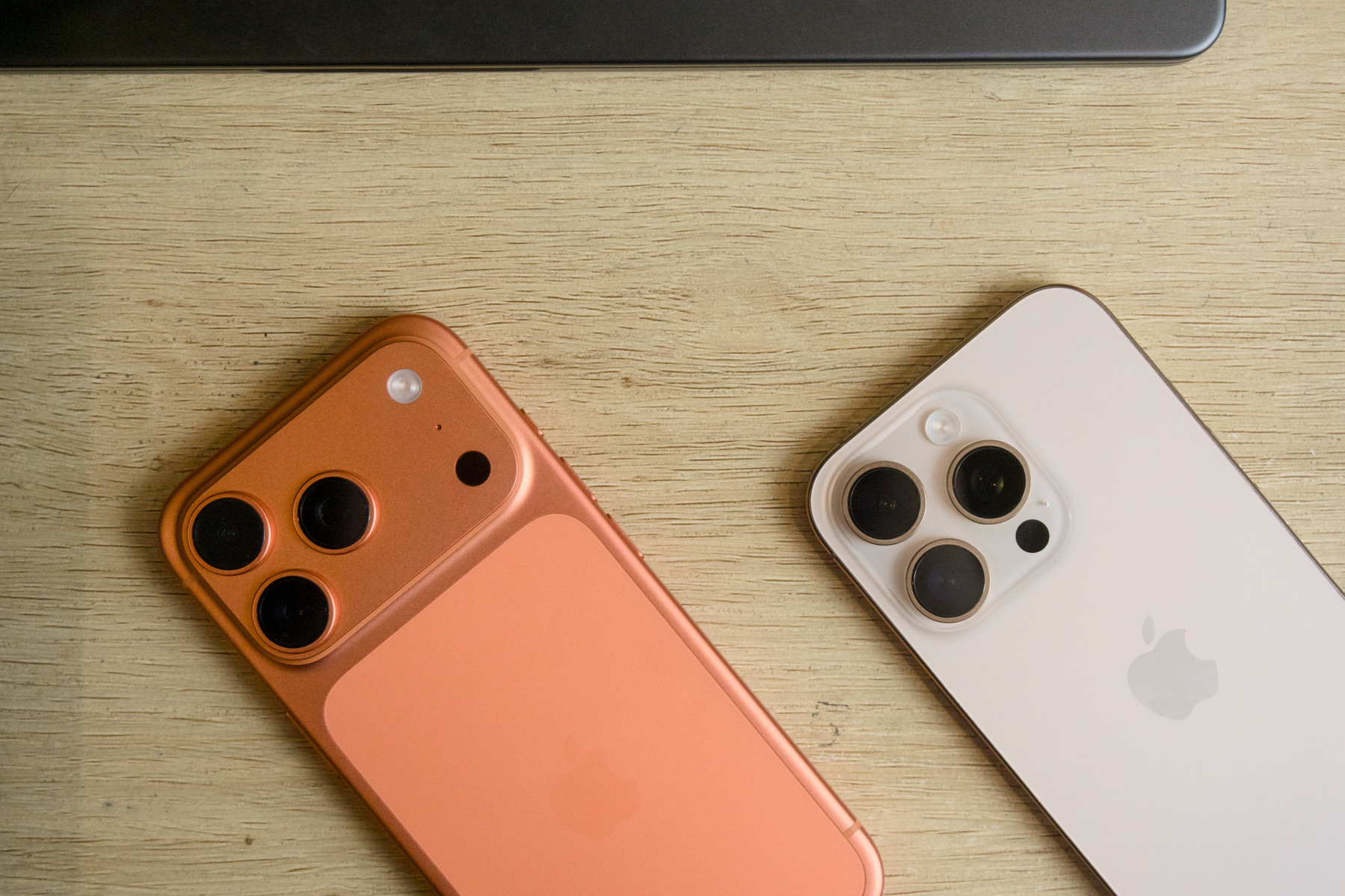 The cameras across iPhone generations are similar in most ways.
The cameras across iPhone generations are similar in most ways.
Battery Life
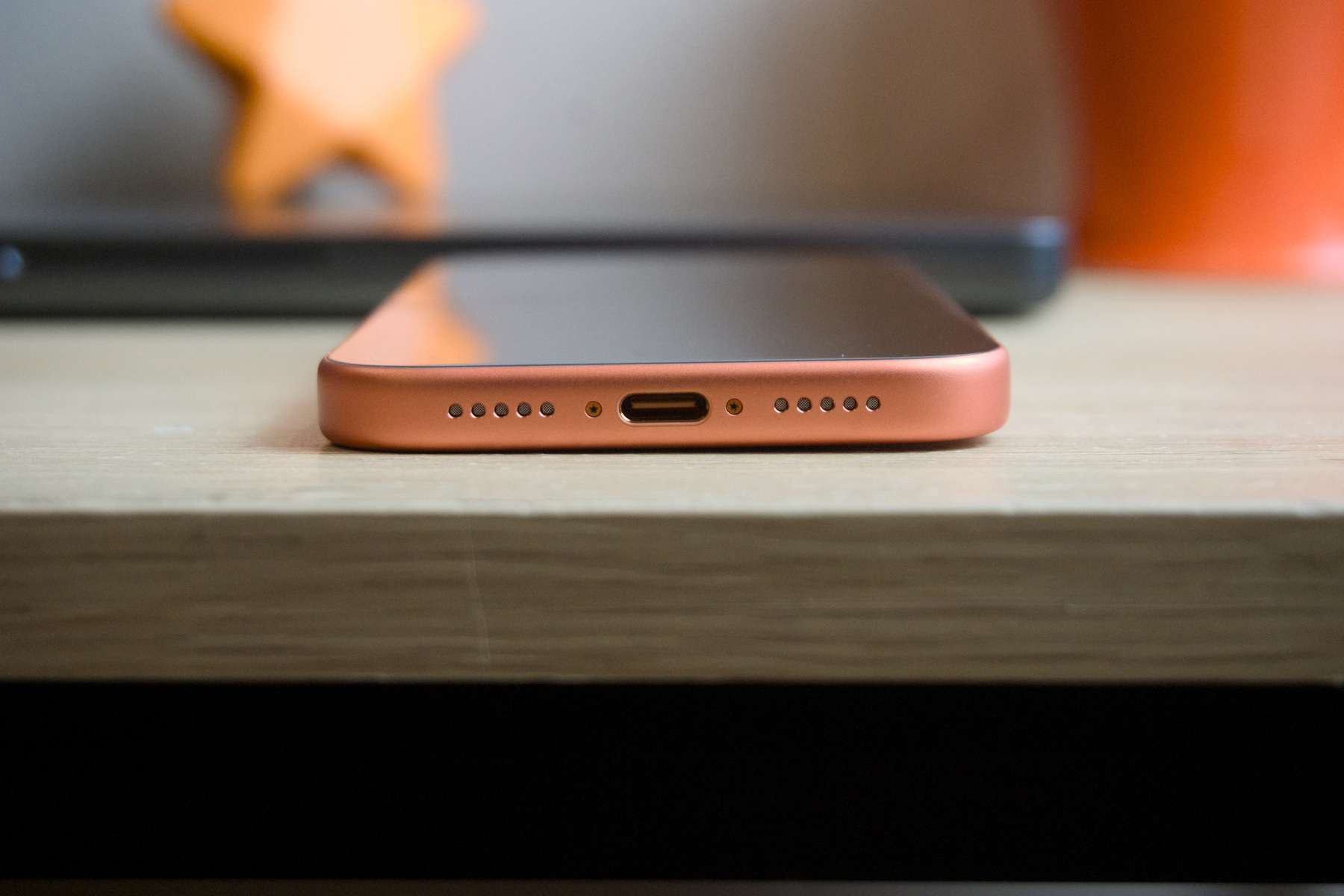 The thicker chassis accommodates the larger battery.
The thicker chassis accommodates the larger battery.
I’ll cut to the chase: iPhone 17 Pro has the best battery life of any non-Max iPhone ever, and by a long shot. If I wanted to, I could make it last two full days. I seldom carve out a section dedicated to battery life in any of my reviews, but my screen time statistics from the device are something to behold. I’ll go out on a limb and say anyone who buys iPhone 17 Pro, regardless of what iPhone they’re upgrading from, will immediately notice that the battery life is the sole reason the device is worth the price.
All of the new models ship with Adaptive Power — a power mode that makes adjustments to battery consumption when deemed necessary — enabled out of the box, even if restoring from a backup. Some commentators speculated that this was an admission that this year’s iPhones have poor battery life, and while that might be true for iPhone Air, it isn’t for the Pro models. Truthfully, I haven’t even noticed Adaptive Power nor received a notification alerting me that Adaptive Power has even kicked in to limit resources. It isn’t analogous to Low Power Mode — which disables a host of useful features like Background App Refresh and ProMotion — and I think everyone should leave it on. Battery life on iOS 26 wasn’t superb on my year-old iPhone 16 Pro, but it somehow is on iPhone 17 Pro, and I’m unsure if Adaptive Power has something to do with it.
I averaged around nine hours of total screen-on time on Wi-Fi, and about eight hours switching between 5G and Wi-Fi. In reality, though, I seldom use my iPhone for more than five hours a day, and the battery easily stretches into the afternoon hours of the next day if I forget to charge it overnight. On a typical workday, I usually have at least 30 percent left in the tank at night, and even when I really pushed the camera, I was still able to get more than enough screen-on time on a single charge. I’m yet to push the device to below 15 percent incidentally — I only did so to test fast charging.
iPhones have never charged particularly quickly, lagging behind Android phones with charging speeds of up to 100 watts.4 The new iPhones charge at 40 watts, with a peak speed of 60 watts with a compatible charger. In practice, this means they charge from 0 to 50 percent in about 20 minutes using a wired charger, and in about 30 minutes using a wireless MagSafe charger, give or take based on charging efficiency. (I measured 45 percent in 20 minutes multiple times.) They charge so quickly, in fact, that the new battery charge estimate on the Lock Screen and in Settings in iOS 26 is inaccurate on the new model; it consistently charges more rapidly than the system estimates. For my tests, I used a 96-watt MacBook Pro, non-gallium-nitride wall charger — not the new “60-watt Max” one Apple sells, which presumably uses GaN. I can confirm this wall charger is unnecessary to charge iPhone 17 Pro at its peak capacity.
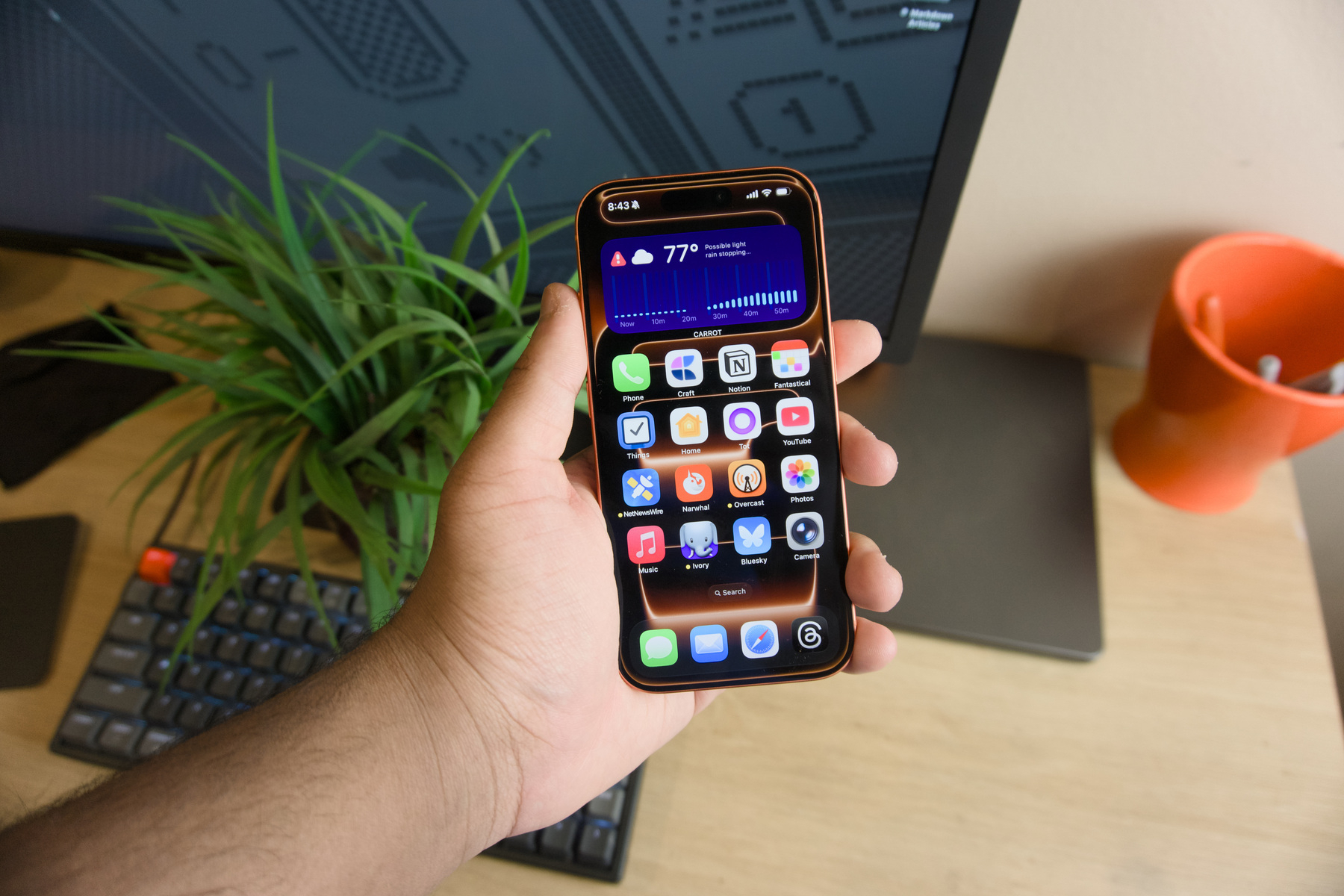 Battery life this year is phenomenal.
Battery life this year is phenomenal.
iPhone 17 Pro, unlike iPhone Air, does not use a silicon-carbon battery, a new technology that replaces the traditional graphite anode in lithium-ion batteries with a silicon-carbon composite. However, the battery is significantly larger due to the phone’s added thickness and, more importantly, the removal of the SIM card slot in U.S. models.5 (The SIM card slot has been absent for a few years, but this is the first time Apple has used the new volume for the battery.) But even if the battery weren’t so much larger, as is the case in international iPhone 17 (sans-Air) models, I still think the A19 Pro’s primary asset is its efficiency, not the modest and negligible gains in graphics and computing performance. The A19 Pro runs cooler and more efficiently than any prior system-on-a-chip on Taiwan Semiconductor Manufacturing Company’s 3-nanometer fabrication process, and it’s immediately apparent why Apple itched to leave the older 3-nm processes behind as soon as possible. Both Apple and TSMC truly have 3-nm fabrication nailed down to a science, and it shows in battery life.
Of every update this year, the most prominent is the marked improvement in battery life, which surpasses any previous year’s that I can remember. I’m quite honestly surprised it hasn’t been mentioned in more reviews because of how noticeable it is — it’s nearly impossible to run the battery down in a day. And when it’s time to charge, it charges much quicker than other iPhones, wired or wireless, which is such an underrated quality-of-life improvement. Maybe these features — especially fast charging — are unimpressive to Android users who have had them for years, but Apple truly outdid itself this year in this department. Full points, no qualms.
Miscellany
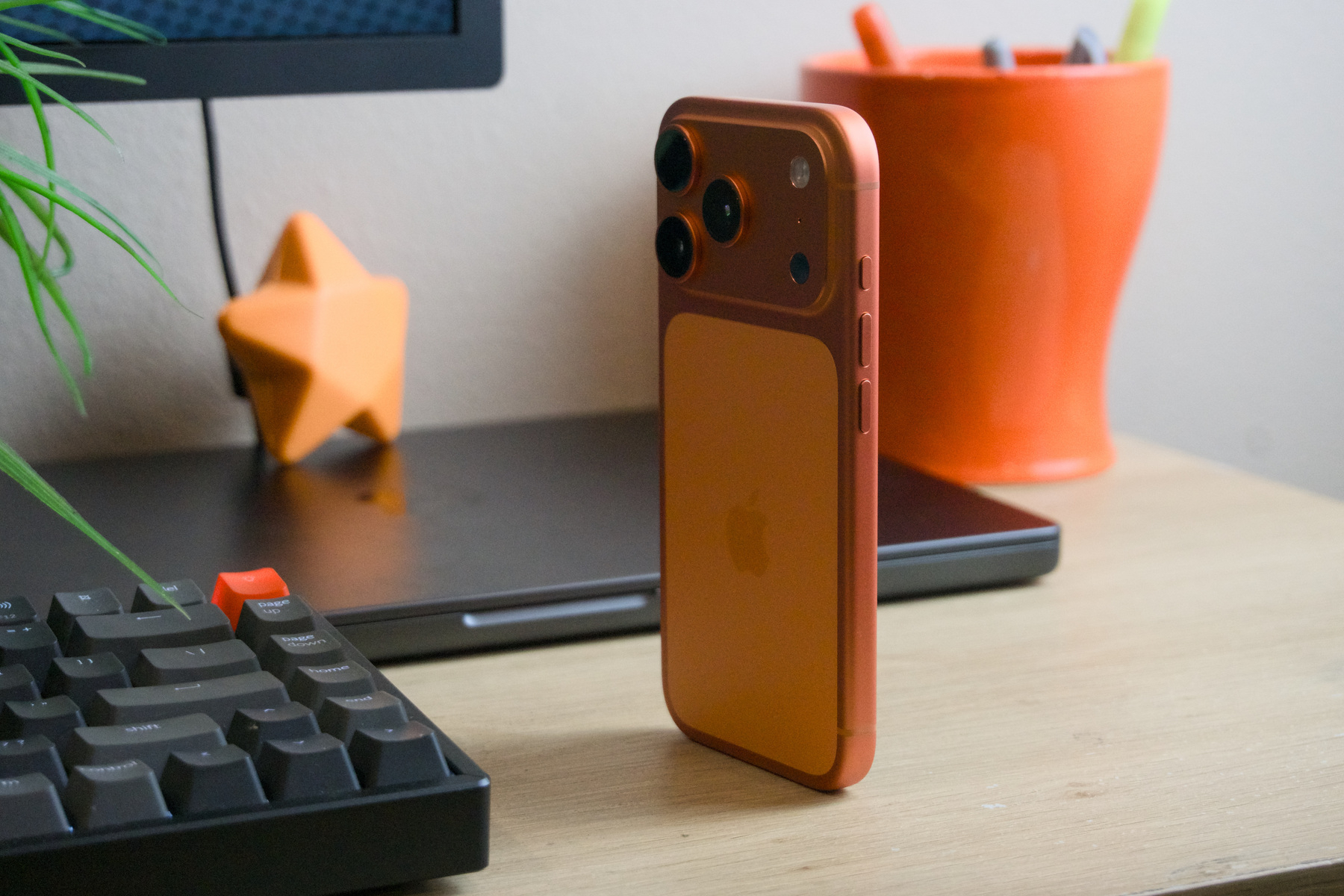 The Action Button still remains.
The Action Button still remains.
With every generation of the iPhone, Apple makes updates to minor aspects of the device that don’t jibe well with any of the main sections that comprise my review. This year, the list is minor because the list of total features is relatively slim, as you can probably tell by this year’s review’s thin word count.
-
The N1 processor, which replaces the third-party Wi-Fi and Bluetooth chips used in prior iPhones and other Apple products, has been rock-solid for me. Apple published a minor update to iOS 26 a week after the new phones launched to address a bug that caused Wi-Fi connections to drop intermittently on N1 iPhones, but I wasn’t plagued by that issue. Both Bluetooth and Wi-Fi have been fast and rock-solid, and while this may be anecdotal, I feel Bluetooth range has improved slightly across my AirPods Pro 2 and AirPods Pro 3. I also suspect the N1 contributes to the improved battery life, and I’m eager to experience the next-generation Apple-made cellular modem in next year’s iPhones. Apple truly has mastered the art of silicon in all areas.
-
An epilogue to the Camera Control section from last year’s review: I find my use of Camera Control is strictly limited to launching the Camera app, and it appears Apple agrees. When setting up an iPhone 17, the Camera Control introduction in Setup Assistant has the setting to allow Camera Control’s swipe gestures disabled by default. I agree with this decision: Swiping through different zoom levels, styles, and exposure was just more cumbersome and slow, even after learning the gestures thoroughly, and the button is positioned inconveniently. I do, however, exclusively use Camera Control to launch the camera, and almost wish I could disable the Lock Screen swipe gesture entirely to prevent accidental photos. Later in iOS 18, Apple modified Camera Control’s behavior so that the screen does not have to be on to use it — one of my most significant issues with the button last year — so it has become ingrained in my muscle memory to click the button whenever I want to snap a quick photo from anywhere in iOS.
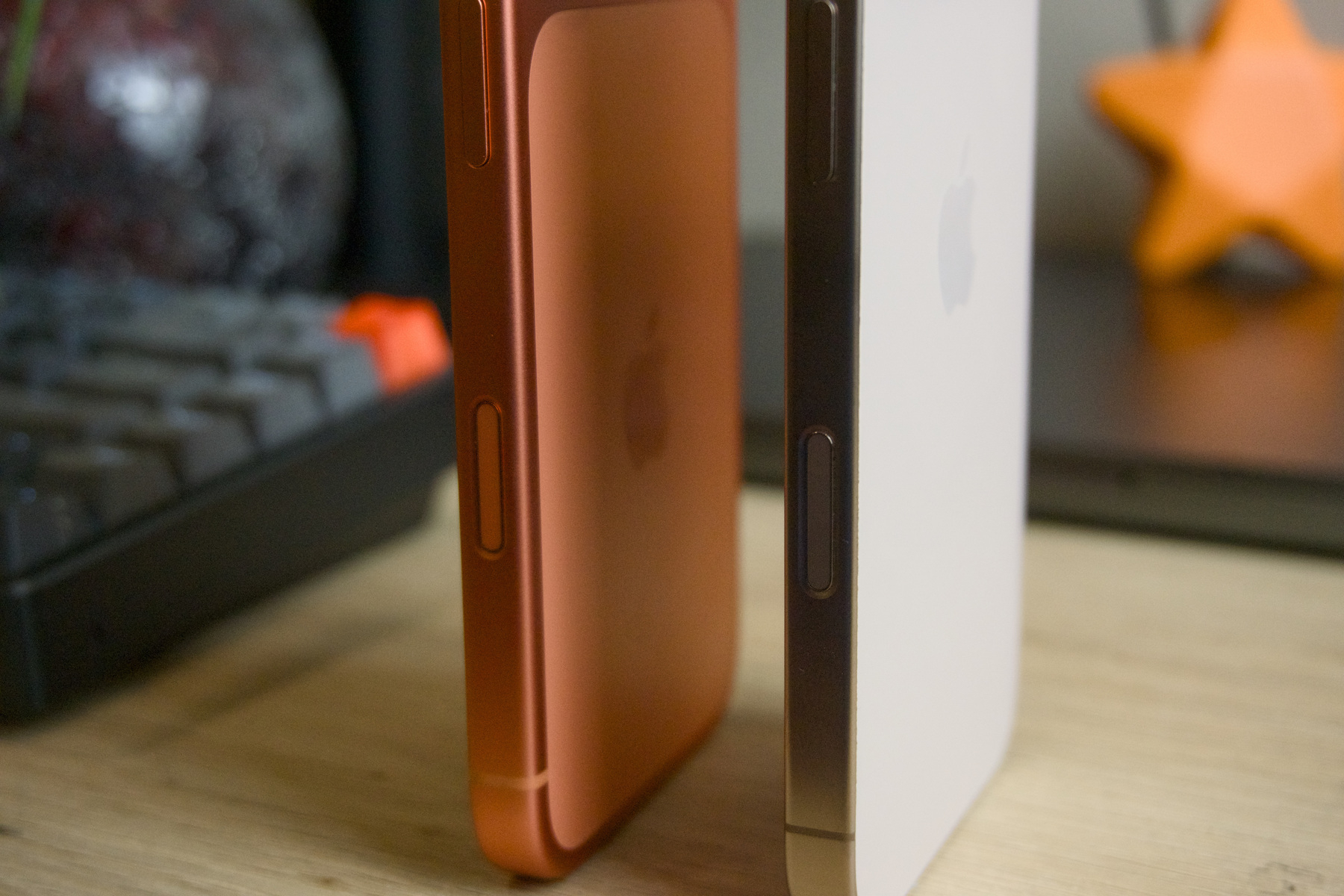 Camera Control remains unchanged from last year.
Camera Control remains unchanged from last year.
-
Dual Capture works fine, but it’s nothing groundbreaking. It really only benefits content creators, most of whom use the built-in recording features of Instagram and TikTok, and it’s not like those apps couldn’t have integrated a similar feature years ago. Filmic Pro was the gold standard for capturing front-facing and rear video concurrently, and I still think that app has an edge over Apple’s version because it allows users to download the two feeds separately. Dual Capture, by contrast, records the video from both cameras to one file, and there is seemingly no option to save both feeds separately and edit them in post. This leads me to believe it’s geared solely for short-form, smartphone-based content creators, but I wonder how large the contingent of creators who use the default camera app to upload to TikTok is.
-
The A19 Pro, performance-wise, is obviously more than satisfactory, and users will really only notice a difference when they upgrade from a much older model. The A19 was clearly designed to run the complex graphics and visual effects of Apple’s latest operating system, and it does a great job compared to even my iPhone 16 Pro. I haven’t noticed any other glaringly obvious performance improvements, however, but that’s fine.
-
The device rocks less on a table due to the more even camera plateau, but it is nevertheless still lopsided and vexing to use on a flat surface. The only solution is for Apple to lay the cameras out horizontally, which would destroy the iPhone’s signature design since iPhone 11 Pro and probably wouldn’t be ideal for durability. Still, Google’s Pixel series reigns supreme in this regard.
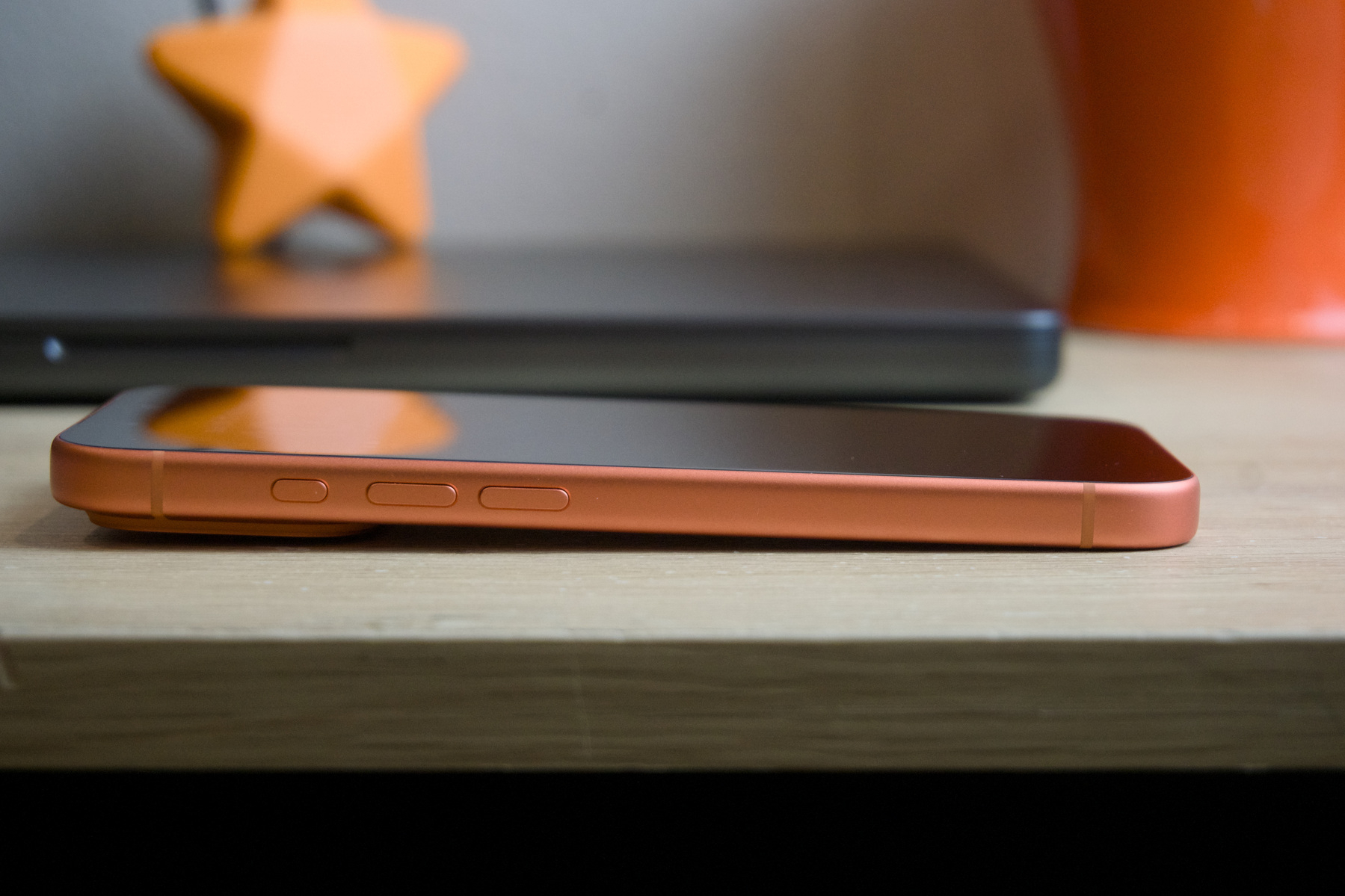 The device still appears lopsided on a table.
The device still appears lopsided on a table.
- While the Apple logo is not centered on the device, the MagSafe coil is, leaving it much higher than one would expect. I’d check the specifications of certain third-party MagSafe chargers to ensure they leave enough clearance, because my first-party one just barely misses the camera plateau by a quarter of an inch. I also find MagSafe chargers are harder to detach and easier to attach compared to prior iPhone models, which might be related to microscopic differences in Ceramic Shield 2’s texture or the aluminum edges.
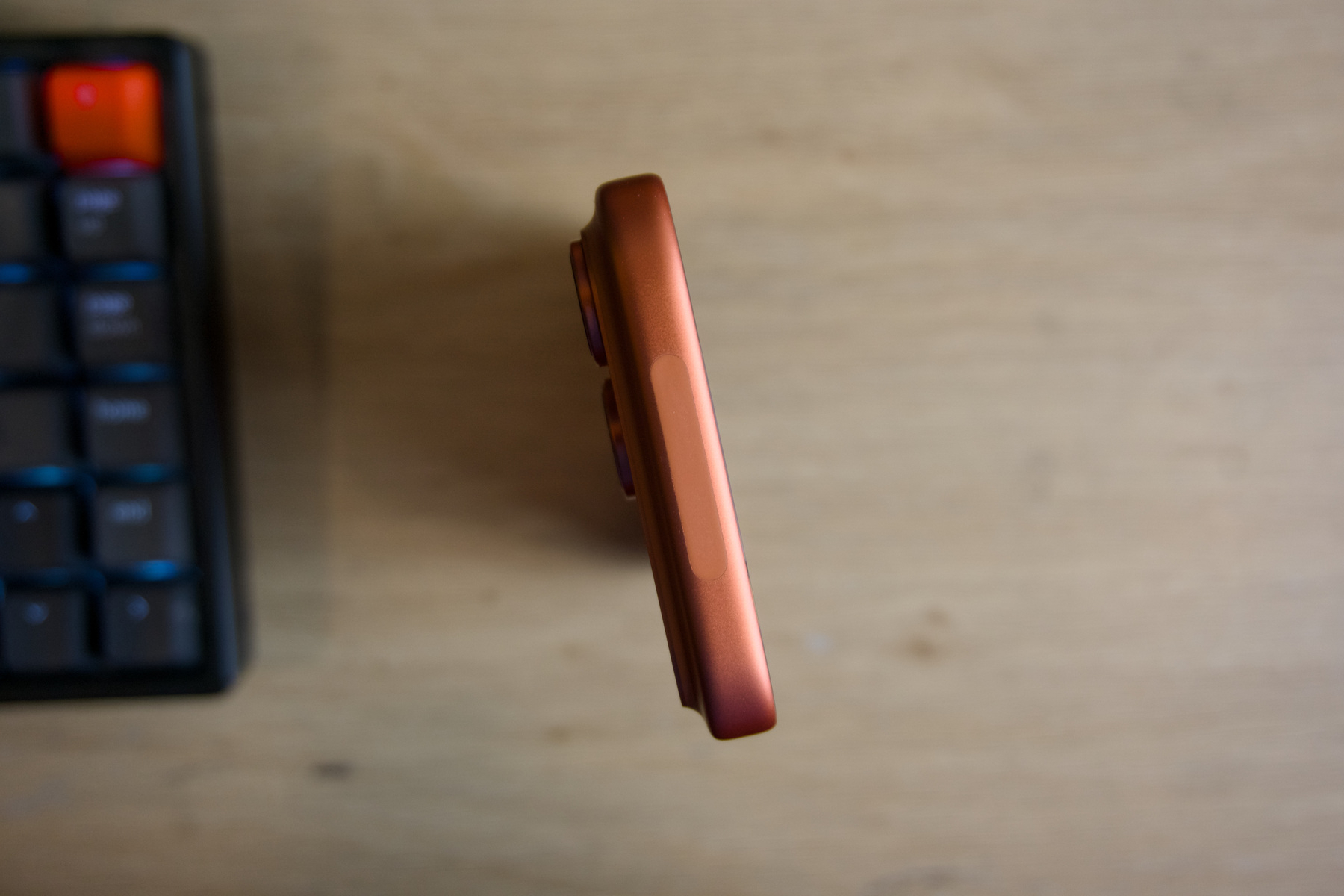 The millimeter-wave antenna makes a return at the top.
The millimeter-wave antenna makes a return at the top.
Over 5,000 words ago, in my lede for this review, I said how this year’s iPhones Pro walk lines parallel to the rest of Apple’s iPhone lineup, taking a few steps forward and a few steps back. The design this year, while having its upsides, is less controversial than I think it ought to be; the camera system is refined and more protean, though manifesting many of the same issues that plagued earlier iPhones; and the battery life is palpably improved thanks to the A19 Pro processor and larger battery capacity. iPhone 17 Pro is a winner — there’s no doubt in my mind — and it takes the lessons Apple has learned over its time building consumer products to cater to the public, which seems overwhelmingly enthused about this year’s releases.
There’s an iPhone for everyone this year, and not one model is “bad” in any sense of the word. At the low end, the iPhone 17 is near-perfect, with a great processor, 120-hertz ProMotion display, excellent cameras, and fantastic battery life. iPhone 17 Pro has even better cameras, much better battery life, and a new design that’s conspicuous, which, like it or not, is what many people — especially in international markets like China and India — purchase a Pro model for. And iPhone Air redefines the iPhone with the most ornate design the lineup has ever had. The 2025 iPhone line is the strongest it has ever been. I don’t mean that in the “This is the best iPhone we’ve ever made” sense, but rather that the lines don’t intersect anywhere. There’s an iPhone for everyone, and they’re all solid choices.
The real lesson to learn from iPhone 17 Pro’s fanfare is that new looks sell. While everyone else and I can criticize the material design of the new iPhone, it’s orange and appears new to the vast 90 percent of people in the market for this device. For Apple, that’s all that matters, and for us, it’s a chance to realign how we think about the iPhone with the broader public. It’s not tainted by any relevant controversy, there are no Apple Intelligence shenanigans to ponder, and there are no glaringly obvious oversights. It’s just a great iPhone that walks its line, parallel to the rest of Apple’s offerings. Nothing more, and certainly nothing less.
-
The title and lede of this review are a reference to Death Cab for Cutie’s “Summer Years.” ↩︎
-
Because this is the new iPhone, there is a new useless controversy surrounding the aluminum finish some have called “scratchgate.” How this is comparable to the Watergate scandal is beyond me, especially in political times like these, but it’s entirely a non-issue. Yes, iPhone 17 Pro will wear worse than prior models when it is dropped, especially around the camera plateau due to the anodization process, but the “scratches” on devices in Apple Stores are not scratches at all; they’re marks from the MagSafe bases the iPhones are lifted from and placed back on thousands of times a day. My own iPhone has yet to have a scratch on its frame. ↩︎
-
You can force this on your iPhone right now. Cover up the telephoto lens with your finger, capture a photo at a telephoto focal length (depending on your iPhone model), then check the EXIF metadata to see which camera it was shot with. It’ll say “Main Camera,” even though you thought it was using a telephoto lens. ↩︎
-
I am well aware that watts measure total energy throughput, whereas amperes measure the rate of electron flow. For this review — which is not a physics lesson — I’ll be using watts to compare charging rates. ↩︎
-
While I initially bemoaned the removal of the physical SIM card in 2022 — so much so that I included a section besmirching eSIM in my iPhone 14 Pro review — I find its omission to be mostly acceptable, if not a net positive, in the modern era. Most, if not all, U.S. carriers offer robust eSIM support across all cellular plans, and switching from iPhone to iPhone or Android phone to iPhone and back is easier as of iOS 17. The process went off without a hitch for me and only took a few minutes; I’d trade a few minutes during setup for over an hour more battery life anytime. (I’m intentionally refraining from commenting on the situation outside the United States, which is diabolical.) ↩︎